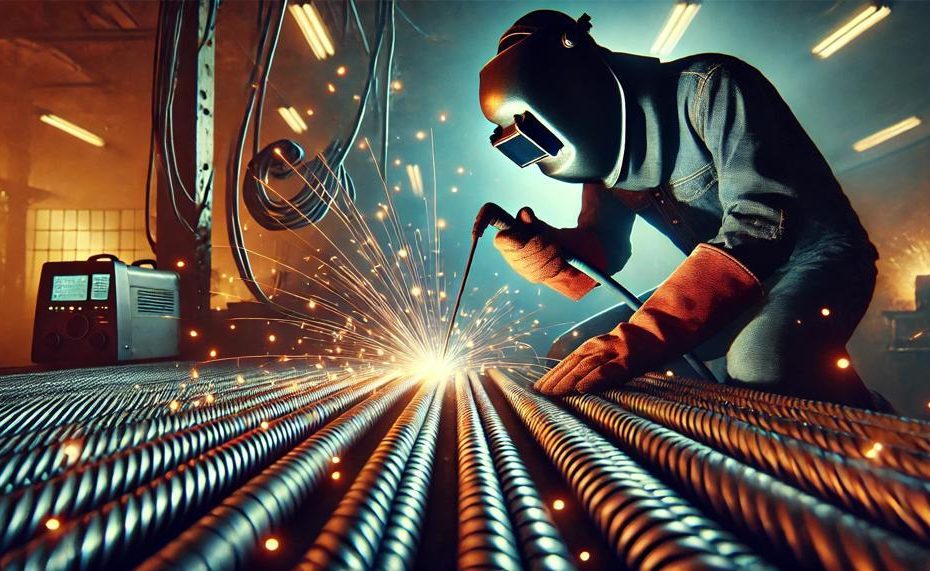Welding rods, those slender sticks of power that bind the world, one metal joint at a time, are the unsung heroes of construction and fabrication. However, these mighty tools demand respect, not just in their use but also in how we store them. Imagine opening a toolbox to find your welding rods compromised, a victim to moisture and neglect. Not exactly the kickoff to a productive day, right? This blog post is your guide to avoiding such scenarios, ensuring your welding rods are kept in tip-top condition, ready to fuse strength into your projects.
We’ll delve into the art and science of storing welding rods, covering essential practices that span from the casual DIY enthusiast to the professional welder. Here’s what you’re in for:
- The Importance of Dryness: Unveiling why moisture is the arch-nemesis of welding rods and how to combat it.
- Temperature Matters: Exploring the role temperature plays in preserving the integrity of your rods.
- Organization is Key: Tips on organizing your rods for efficiency and longevity, ensuring the right rod is always at hand.
- Special Storage Solutions: A peek into the tools and containers designed to keep your welding rods pristine.
- Long-Term vs. Short-Term Storage: Tailoring your storage solutions based on how long you plan to store your rods.
By the end of this post, you’ll be equipped with the knowledge to extend the life of your welding rods, saving you time and money, and ensuring your welds are as strong as they can be. So, buckle up, and let’s dive deep into the world of welding rod storage, a topic less discussed but crucial for any welder’s success.

Contents
- 1 WHY DO YOU NEED TO PROPERLY STORE ELECTRODES?
- 2 HOW WELDING ELECTRODES SHOULD BE STORED
- 3 STORING OPTIONS (FOR HOBBYISTS AND PROFESSIONALS)
- 4 MYTHS ABOUT STORING ELECTRODES AT HOME
- 5 CAN YOU DRY WET WELDING RODS
- 6 HOW TO DRY STICK WELDING RODS (PROFESSIONALS AND HOBBYISTS)
- 7 DO WELDING RODS HAVE A SHELF LIFE?
- 8 SIGNS THAT RODS ARE NOT USABLE OR ARE EXPIRED
- 9 Conclusion
WHY DO YOU NEED TO PROPERLY STORE ELECTRODES?
Storing welding rods correctly is pivotal; it’s the linchpin that keeps the quality and safety of your welding work from teetering on the edge. Let’s break it down, nice and easy, into why this matters and what happens if you chuck caution to the wind.
Why Proper Storage Matters
| Moisture’s Mischief | Moisture is a right old troublemaker for welding rods. It invites rust, ushers in hydrogen embrittlement, and flings contamination into the mix, muddying up your welds. |
| Contamination Caper | Dust and debris are no friends to your welding rods. They sneak in, degrade the quality of your welds, and can turn a top-notch rod into nothing more than a stick. |
| Physical Damage Dilemma | A welder’s nightmare is finding their rods bent or broken. Mishandling or poor storage can lead to physical damage, making rods fit for the bin, not the bench. |
| Environment Essentials | Keeping rods in a cool, dry place shields them from moisture and heat, which can warp or weaken them. |
| Type Tangle | Mixing different types of rods? That’s asking for trouble. Cross-contamination or corrosion can creep in, spoiling your stock. |
Consequences of Shoddy Storage
Let’s not mince words—skimping on storage spells trouble. Here’s the lowdown:
- Weak Welds: If moisture has its way with your rods, expect your welds to be about as strong as a wet paper bag.
- Safety Snafus: Damaged or contaminated rods aren’t just a pain; they’re downright dangerous. Poor welds can fail, putting a dent in more than just your reputation.
- Costly Conundrums: Think of each spoiled rod as money down the drain. Costs can balloon with delays, rework, or having to replace your stash.
- Standards Slip: In the welding world, standards are king. Use dodgy rods, and you might find your work doesn’t measure up.
HOW WELDING ELECTRODES SHOULD BE STORED
To guarantee the longevity and effectiveness of welding electrodes, it’s imperative to store them under conditions that prevent moisture penetration and physical damage. Here’s a breakdown of the optimal storage practices:
| Storage Condition | Why It Matters | How to Achieve |
| Dry Environment | Moisture is the arch-nemesis of welding electrodes, leading to compromised coatings and reduced weld quality. | Use airtight containers or specialized storage ovens to keep humidity at bay. |
| Avoid Physical Damage | Dents or breaks in the electrodes can impair their performance, leading to flawed welds. | Handle with care and store in a manner that prevents them from being dropped or bent. |
| Temperature Controlled | Extreme temperatures can alter the chemical composition of the electrodes, affecting their welding capabilities. | Maintain a stable temperature environment, ideally between 10°C and 50°C (50°F and 122°F). |
| Original Packaging | The manufacturer’s packaging is designed to protect the electrodes from environmental damage. | Keep unused electrodes in their original packaging until needed. |
| Vertical Orientation | This prevents the accumulation of dust and debris on the electrodes, which could contaminate welds. | Store electrodes vertically in racks or containers designed for this purpose. |
Remember, mates, just like a seasoned angler takes care of his fishing rods, you’ve got to treat your welding electrodes with respect. Keep ’em dry, safe, and snug in their beds (read: storage containers), and they’ll be ready to perform when you are. No shortcuts here—proper storage isn’t just a good practice; it’s your ticket to reliable and top-notch welds every time. So, don’t let moisture play spoilsport, and handle those electrodes like the precious commodities they are.
STORING OPTIONS (FOR HOBBYISTS AND PROFESSIONALS)
Storing welding rods effectively is akin to preserving the sharpness of a craftsman’s tools; it requires insight, diligence, and a touch of finesse. Whether you’re a hobbyist tinkering in your garage or a professional shaping the skeleton of our modern world, the integrity of your welding rods is paramount. Here’s how to keep them in prime condition:
Temperature and Humidity Mastery
| Method | Description | Benefit |
| Dehumidifiers/Air Conditioners | Use in storage areas to control ambient conditions. | Prevents moisture absorption and rust. |
| Airtight Containers | Transfer rods from damaged packaging to sealed containers. | Shields against dirt and further moisture ingress. |
Strategic Placement and Care
| Storage Orientation | Rationale | Outcome |
| Vertical Storage | Avoids bending/warping over time due to weight distribution. | Maintains rod straightness and performance. |
| Rotation System | Older rods used before newer ones to avoid expiration. | Ensures quality welds; maximises rod lifespan. |
Segregation for Success
| Type Separation | Purpose | Advantage |
| Different Rod Types (Stick, MIG, TIG) | Avoids cross-contamination and confusion. | Precise application and reduced flux loss. |
| Labeled Containers/Shelves | Facilitates easy identification and retrieval. | Streamlines workflow and reduces errors. |
In essence, managing your welding rods with the care they demand involves more than just finding them a home; it’s about creating an environment where they can remain at their peak potential. For hobbyists, this might mean dedicating a small, climate-controlled corner of the garage with clearly labeled jars or tubes. For professionals, it could translate into investing in industrial-grade storage solutions that safeguard the backbone of their trade.
Remember, the quality of your welds is only as good as the condition of your rods.
MYTHS ABOUT STORING ELECTRODES AT HOME
When it comes to storing welding rods at home, there’s a fair share of folklore out there. Let’s set the record straight and debunk some of these myths with the hard facts.
| Myth | Common Belief | The Truth |
| Welding rods can be stored anywhere. | Anywhere’s fine – garage, shed, you name it. | Not quite right. They need a clean, dry, and airy spot to avoid moisture and dirt contamination. |
| Storing welding rods in an airtight container is necessary. | Airtight keeps ’em fresh, right? | Actually, no. Airtight can trap moisture, leading to rust. Ventilation’s key. |
| Welding rods have an expiration date. | Use ’em quick or toss ’em. | They’re more durable than you think. No expiry, but keep ’em dry and cool to preserve quality. |
| Keeping welding rods in a cold environment will extend their shelf life. | Colder is always better. | A myth. Extreme cold can make them brittle. Room temperature is best. |
| Unused welding rods can be reused indefinitely. | They last forever. | Not entirely true. While they don’t expire, their performance might degrade if not stored properly. |
Cracking these myths wide open, it’s clear that the key to keeping your welding rods in tip-top shape boils down to proper storage. Forget about chucking them just anywhere or sealing them up tight; a clean, dry space is what they’re pining for. And while they’re not ticking time bombs waiting to expire, treating them with a bit of care by following the manufacturer’s storage guidelines will ensure they’re ready for action when you are.
CAN YOU DRY WET WELDING RODS
Absolutely, you can dry wet welding rods. It’s a bit of a pickle when your welding rods get soggy because it messes with their performance big time. Wet rods can make your welds weaker and even lead to a bit of a shock hazard for you. But fret not, there’s a way to sort them out and get them back in tip-top shape.
What Happens When Welding Rods Get Wet?
Moisture is no friend to welding rods. It can cause the flux coating to go off its rocker, making for some pretty shoddy welds. Plus, it can make the rods rust or corrode, which is not what you want when you’re trying to create something sturdy. And let’s not forget, wet rods could turn you into a human lightning rod—definitely not ideal.
How to Dry Those Soggy Rods
| Step | Method | Details |
| 1 | Wipe Off Excess Moisture | Use a clean, dry cloth or paper towel to dab off any surface water. |
| 2 | Drying Oven | A drying oven is your best bet for thorough drying. Keep it on the low to avoid damaging the rods. |
| 3 | Air-Dry Option | If an oven’s not handy, spread ’em out in a breezy spot. Flip them regularly for even drying. |
| 4 | Check Instructions | Some rods come with specific drying dos and don’ts from the manufacturer. Worth a look-see. |
| 5 | Storage Post-Dry | Once they’re bone-dry, stash them in a dry spot to avoid any future water woes. |
HOW TO DRY STICK WELDING RODS (PROFESSIONALS AND HOBBYISTS)
To ensure that stick welding rods deliver optimal performance and longevity, both professionals and hobbyists need to adopt effective drying practices. Here’s a straightforward guide to successfully drying your welding rods:
Step-by-Step Guide to Drying Welding Rods
| Step | Action | Notes |
| 1 | Check Humidity Level | Ensure the storage space humidity is below 70%. |
| 2 | Preheat Oven | Aim for a temperature range of 250-300°F (121-149°C). |
| 3 | Spread Out Rods | Avoid contact between rods for even heating. |
| 4 | Oven Time | Place on a baking sheet and into the oven. |
| 5 | Monitor Temperature | Keep within the ideal 250-300°F range. |
| 6 | Watch for Discoloration | Darker shades indicate potential overheating. |
| 7 | Cool Down Process | Allow to cool in the oven to room temperature. |
Tips and Alternatives
- Using a Welding Rod Dryer: For those who weld frequently, investing in a welding rod dryer could be a wise choice. It offers precise control over temperature and timing, ensuring your rods are perfectly dried.
- Portable Electrode Stabilizing Oven: Ideal for on-the-go welders, these compact ovens ensure rods are dry wherever you’re working.
- Usage Window Post-Drying: Once dried, it’s crucial to use the welding rods promptly. Over time, exposed rods can reabsorb moisture from the air, negating the drying process.
DO WELDING RODS HAVE A SHELF LIFE?
Yes, welding rods indeed have a shelf life, which can significantly vary based on the type of rod and the storage conditions. The longevity and performance of welding rods are intricately tied to how they’re kept, with moisture and improper temperature being the main culprits that can render them less effective or even unusable.
Over time, if not stored correctly, welding rods may crack, absorb moisture, or suffer other forms of damage that compromise their integrity and performance.
Optimal Storage Conditions for Welding Rods
| Storage Factor | Impact on Shelf Life | Recommended Conditions |
| Moisture | Negatively affects most welding rods, leading to potential hydrogen cracking. | Keep in a dry place; use dehumidifiers if necessary. |
| Temperature | Extreme temperatures can cause damage or spoilage. | Maintain a stable, moderate temperature. |
| Physical Damage | Can occur with poor handling or storage. Cracks or bends affect performance. | Store in original packaging when possible; handle with care. |
Shelf Life Insights
The shelf life of welding rods does hinge on their model and the conditions under which they’re stored. Generally speaking, many welding rods will remain viable for several years if stored under ideal conditions. However, this is a ballpark figure, and specific storage recommendations can vary dramatically between different types of rods.
Moisture is particularly detrimental. It doesn’t just sit on the surface; it seeps into the very makeup of the rod, potentially causing hydrogen to be introduced into the weld pool, leading to cracking and porosity in the finished weld. That’s why keeping them bone dry is more than just a good practice—it’s essential.
SIGNS THAT RODS ARE NOT USABLE OR ARE EXPIRED
Recognizing the signs that welding rods are past their prime is akin to understanding the subtle cues nature gives us when something’s amiss. Here’s a straightforward rundown of key indicators that your welding rods may have thrown in the towel:
| Physical Damage | Look out for rods that are bent, cracked, or show signs of corrosion. Such physical flaws can weaken the rod, leading to breakage during welding and potentially injurious outcomes. |
| Moisture Damage | If your rods have been lounging in humid conditions, they might’ve soaked up moisture like a sponge, becoming brittle and less effective. A hissing or popping sound during welding is a giveaway that moisture’s making a hasty exit from the rod. |
| Discoloration | A fresh rod gleams with a shiny metallic sheen, while an expired one looks as dull as dishwater or shows strange hues. Discoloration could stem from undue heat or humidity exposure, messing with the rod’s chemical makeup. |
| Performance Dip | When your welding starts to look more splatter art than smooth seam, consider the state of your rods. Deterioration of the flux coating can wreak havoc on arc stability and lead to inconsistent welds. |
In essence, keeping an eagle eye on these signs ensures you’re not caught off-guard mid-weld by a rod that’s decided it’s time to retire. Proper storage is the key to elongating their life span – keep them dry and cool, away from the whims of weather and humidity.
Should you spot any of these tell-tale signs, it might be time to bid farewell to those rods and restock your arsenal with fresh ones.
Conclusion
Finally, if you want to become a great welder, you need to make sure you store your welding tools properly. The climate can damage these thin power sticks, even though they look unbreakable. Moisture is their worst enemy, and chaos is their worst enemy.
This complete guide has shown you all the important things you need to know to keep your welding rods in good shape, from keeping them dry with closed cases or special storage ovens to understanding how important it is to keep the right temperature and keep things in order.
Don’t forget that your welding rods are more than just tools; they are what make your welds strong. Respecting them by storing them in the best way possible isn’t just about making them last longer; it’s also about protecting the value of your work. Whether you’re an amateur working in your yard or a professional welder building the world we live in today, these tips will make sure that your rods are ready and effective when it’s time to strike an arc.
As a motto, remember to “keep ’em dry, clean, and safe.” By following these store rules, you can avoid weak welds, safety problems, expensive problems, and standards decline. Not only will this save you time and money, but it will also make sure that every weld you make stands the test of time, showing how much skill and care went into making it.





